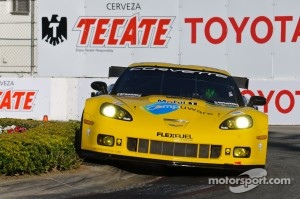
Photo by: Adriano Manocchia
Corvette Racing at Baltimore Grand Prix: The Science of Street Racing
Software, Simulations, and Experience Prepare Corvette Racing for Inaugural Baltimore Race
BALTIMORE, Aug. 31, 2011 – Before the first practice session at the inaugural Baltimore Grand Prix begins, Corvette Racing's twin Compuware Corvette C6.R race cars will already have made dozens of laps on the downtown street circuit – thanks to sophisticated computer simulations.
The first race on the 2.1-mile, 12-turn temporary street circuit is a journey into the unknown for American Le Mans Series teams. With limited practice time before Saturday's two-hour race, every second on the track is precious. In order to maximize the Corvettes' performance, the engineering team has analyzed the layout and developed chassis setups on a virtual track.
"Beginning with drawings provided by the organizers, we developed a projected racing line based on the geometry of the track," said Corvette Racing engineering director Doug Louth. "Then the engineering team ran simulated laps to optimize gear ratios and chassis setups. We've prepared maps for the drivers that show projected shift points, maximum and minimum speeds, and potential passing zones."
This proprietary simulation program is used in a variety of GM motorsports programs, from ALMS and Grand-Am road racing to NASCAR. It's also used by engineers in the production Corvette group and other technology partners.
"The big variable on street circuits is the pavement," Louth noted. "While we have data about elevation changes and the crown in the road, we won't know how smooth or rough the asphalt is until we're on site. There could be bumps that require adjustments in the racing line, or the organizers might make last-minute changes in the barriers and cones that define the track perimeter. We have to be prepared for these possibilities.
"Corvette Racing's years of experience on street circuits is definitely an asset," he added. "We've raced on smooth tracks and on rough ones, so we have the background to handle whatever we find in Baltimore. We have a list of high-priority items to work through in the limited track time that's available. All of the ALMS teams are in a similar situation, so hopefully we can do a better job than our competitors. It's exciting to go to a new venue in a major metropolitan area, and this event is another step forward for the American Le Mans Series."
Corvette Racing's drivers know how to win on street courses. Olivier Beretta (No. 3 Corvette C6.R) and Oliver Gavin (No.4 Corvette C6.R) are the most successful ALMS drivers on temporary circuits with seven wins each. In the Series' last visit to the mid-Atlantic area at RFK Stadium in Washington, D.C., in 2002, Jan Magnussen (No. 4 Corvette C6.R) scored an overall win in a Panoz LMP1 prototype.
But all eyes in Baltimore will be on the youngest driver on the Corvette Racing squad, Tommy Milner. Milner was born in the District of Columbia and grew up in nearby Virginia. Last Sunday, he opened the Baltimore GP festivities by throwing the first pitch at a Baltimore Orioles/New York Yankees baseball game at Camden Yards, which is located inside the street circuit.
"The last time the Series raced in the mid-Atlantic area, the event got great reviews," Milner said. "I'm optimistic that the Baltimore Grand Prix will be a success. Many of my friends have never seen me race except on television, and they're excited about going to this race. I'll have lots of support in the grandstands.
"This race is going to be a real test," he noted. "With most circuits, a driver can learn the layout on a simulator or a video game, but we don't have that option for the Baltimore race. Street tracks are always tough because there is not a lot of grip initially, and the surface changes quite a bit from the first practice to the race.
"A good baseline setup makes it easier to get acclimated to a new track, and I'm confident that the Corvette Racing crew will give us one," Milner explained. "I'm comfortable with the Corvette C6.R on a street circuit after coming from the back of the pack in Long Beach. I consider Baltimore to be my home race, and I want to do as good a job as possible. Every driver is on equal footing, and it's all brand new. I feel confident that we'll be on pace right away."
Be part of Motorsport community
Join the conversationShare Or Save This Story
Subscribe and access Motorsport.com with your ad-blocker.
From Formula 1 to MotoGP we report straight from the paddock because we love our sport, just like you. In order to keep delivering our expert journalism, our website uses advertising. Still, we want to give you the opportunity to enjoy an ad-free and tracker-free website and to continue using your adblocker.

















Top Comments